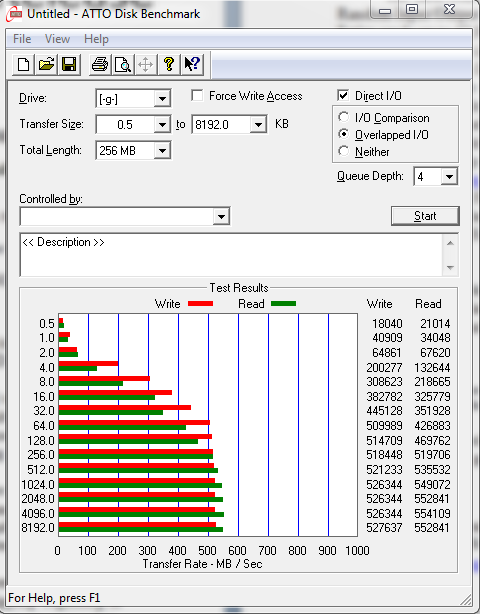ATTO Disk Benchmark is perhaps one of the oldest benchmarks going and is definitely the main staple for manufacturer performance specifications. ATTO uses RAW or compressible data and, for our benchmarks, we use a set length of 256mb and test both the read and write performance of various transfer sizes ranging from 0.5 to 8192kb. Manufacturers prefer this method of testing as it deals with raw (compressible) data rather than random (includes incompressible data) which, although more realistic, results in lower performance results.
Intel specifications list 500MB/s read and 450MB/s write performance while our ATTO results brings us 552MB/s read and 527MB/s write; this is what we meant by LSI SandForce performance.
CRYSTAL DISK BENCHMARK VER. 3.0 X64
Crystal Disk Benchmark is used to measure read and write performance through sampling of highly compressible data (oFill/1Fill), or random data which is, for the most part, incompressible. In the Intel 335, we have displayed testing using highly compressible data on the left, compared to that of incompressible on the right.

 Crystal DiskMark results always tend to be a bit lower than ATTO and it is definitely good news seeing such high 4K random write performance, although we have to admit we pulled a couple extra attempts at trying for the 100MB/s mark for those low 4K write speeds.
Crystal DiskMark results always tend to be a bit lower than ATTO and it is definitely good news seeing such high 4K random write performance, although we have to admit we pulled a couple extra attempts at trying for the 100MB/s mark for those low 4K write speeds.
Up until recently, AS SSD was the only benchmark created specifically for SSD testing and it uses incompressible data. AS SSD, for the most part, gives us the worst case scenario in SSD transfer speeds because of its use of incompressible data and many enthusiasts like to AS SSD for their needs. Transfer speeds are displayed on the left with IOPS results on the right.

 Our AS SSD benchmarks are typical of what we see in most ‘LSI SandForce Driven’ drives today and that is encouraging as the main concerns with new memory being introduced to market are the give and takes. If asked my personal preference as to which specific characteristic of AS SSD I look at closest these days, it is definitely the AS SSD Copy Benchmark below.
Our AS SSD benchmarks are typical of what we see in most ‘LSI SandForce Driven’ drives today and that is encouraging as the main concerns with new memory being introduced to market are the give and takes. If asked my personal preference as to which specific characteristic of AS SSD I look at closest these days, it is definitely the AS SSD Copy Benchmark below.
Not only does it provide a testing scenario that is pretty much as close to reality as one can get, but also, it’s performance is simply based on the maximum speed reached and time it takes to transfer three files from one part of the SSD to another. Only within the last few months are we seeing newer SSDs reaching consistently high SATA 3 speeds and lightning fast copy speeds. This is an excellent example.
 The SSD Review The Worlds Dedicated SSD Education and Review Resource |
The SSD Review The Worlds Dedicated SSD Education and Review Resource | 

From your comments, it seems like this is equivalent in performance to 330 SSD, but the price in not much lower than current prices… in fact, today the 335 is more expensive on newegg than 330! (how does that happen?)… I am sure it will change. Is there something else I am missing on this SSD that makes it better for consumer? Just asking….
Technology is what makes this SSD so interesting. I must admit that I never expected retailers to actually up the manufacturers suggested listed price. For the most part, 20 nm memory increases the potential value and potential size of solid-state drives. Thanks ahead.
agreed, using 20nm is great. IF the price goes down due to 20nm, then it is interesting. So Intel and Plextor are the only companies with 19nm/20nm SSDs now?
BAD DRIVES – Sorry for OT, but Anandtech tested Intel 335 240GB (IMFT 20nm sync):https://www.anandtech.com/show/6388/i…240gb-review/2
“In a few days, I managed to write a total of 37.8TB to the NAND and during that time, the MWI had dropped from 92 to 79. In other words, I used up 13% of the drive’s available P/E cycles. This is far from being good news. Based on the data I gathered, the MWI would hit 0 after around 250TB of NAND writes, which translates to less than 1,000 P/E cycles.”
Is there a reason for using very old Crystal Disk Info for test? Intels 330 shows the Host Write and NAND Write, I ask whether the 335 also can show that?
The latest version of Crystal Disk Info is only a recent release and we will update for future review. Thanks ahead!